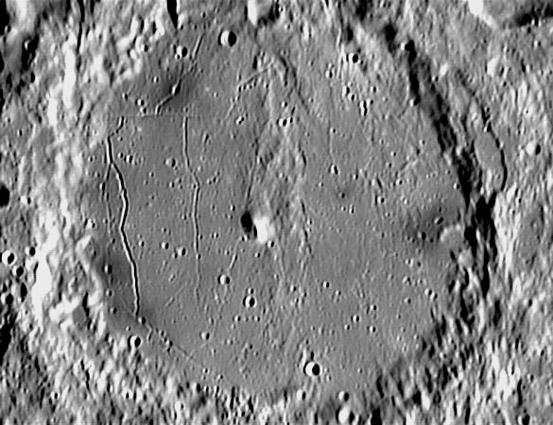Difference between revisions of "May 21, 2004"
(Created page with "__NOTOC__ =Volcanic Craters on the Moon= ---- ===COMMENTS?=== Click on this icon image:PostIcon.jpg at the upper right to post a comment.") |
|||
| (7 intermediate revisions by the same user not shown) | |||
| Line 1: | Line 1: | ||
__NOTOC__ | __NOTOC__ | ||
=Volcanic Craters on the Moon= | =Volcanic Craters on the Moon= | ||
| − | + | <!-- Start of content --> | |
| − | + | <p align="center"> | |
| − | + | <table width="640" border="0" align="center" cellpadding="6" cellspacing="2"> | |
| − | ---- | + | <tr> |
| − | === | + | </tr></table> |
| − | + | <table border="0" align="center" cellpadding="6" cellspacing="2"> | |
| + | <tr> | ||
| + | <td><div align="center"> | ||
| + | [[File:LPOD-2004-05-21.jpeg|LPOD-2004-05-21.jpeg]] | ||
| + | </div></td> | ||
| + | </tr> | ||
| + | <tr> | ||
| + | <td colspan="2"><div align="center"> | ||
| + | <p class="main_sm">Image Credit: [mailto:Bruno.DAVERSIN@lahague.com Bruno Daversin]</p> | ||
| + | </div></td> | ||
| + | </tr> | ||
| + | <table class="story" border="0" bgcolor="#FFFFFF" width="90%" cellpadding="10" align="center"> | ||
| + | <tr> | ||
| + | <td><p class="Story" align="center"><b>Volcanic Craters on the Moon</b></p> | ||
| + | <p class="story" align="left">At one time or another nearly all lunar craters from Copernicus to Messier have been consider volcanic - but virtually all craters can now be convincingly re-interpreted as products of impact cratering. So, are there any volcanic craters on the Moon? Yes, a few, and Bruno Daversin has produced an excellent image of those on the floor of Alphonsus. But first, how do we know they aren't impact craters? (1) They are not circular. (2) They are surrounded by dark halos. (3) They occur along rilles. (1) and (2) can be explained by impact processes, but (3) is unlikely to result from impact. Spectral studies also show that the dark haloes are pyroclastic (ashy) material, not fragmental mare rocks. Considering all of these characteristics together makes volcanism the only reasonable interpretation. In the early 1970s Tom McGetchin and Jim Head compared these craters to terrestrial cinder cones. On Earth, cinder cones, such as Sunset Crater in northern Arizona, are tall and have steep (30 degrees) sides. Head and McGetchin realized that with the Moon's lower gravity and lack of atmosphere, exactly the same eruption on the Moon would produce a broad and low crater very much like these dark halo ones in Alphonsus.</p> | ||
| + | <p class="story" align="left"><b>Technical Details:</b><br> | ||
| + | Image obtained with Ludiver Observatory (Normandy, France) 600 mm (24") F/D=16 cassegrain telescope + infrared filter + TouCam Pro in B&W mode. </p> | ||
| + | <p class="story"><b>Related Links:</b><br> | ||
| + | [http://www.ludiver.com/conquerir_espace_scientifique_lune.php Ludiver Observatory]<br> | ||
| + | [http://www.lpi.usra.edu/publications/slidesets/hawaiivolcanoes/slidespages/slide_14.html Alphonsus Crater - Apollo 16 view] | ||
| + | <br> | ||
| + | [http://volcano.und.nodak.edu/vwdocs/volc_images/img_sunset.html Sunset Crater ] </p> | ||
| + | <p><b>Yesterday's LPOD:</b> [[May 20, 2004|A Tunnel Thru the Moon?]] </p> | ||
| + | <p><b>Tomorrow's LPOD:</b> [[May 22, 2004|Lunar 100]] </p> | ||
| + | </tr> | ||
| + | </table> | ||
| + | <hr> | ||
| + | <p align="center" class="main_titles"><b>Author & Editor:</b><br> | ||
| + | [mailto:tychocrater@yahoo.com Charles A. Wood]</p> | ||
| + | <!-- Cleanup of credits --> | ||
| + | <!-- Cleanup of credits --> | ||
| + | <!-- Cleanup of credits --> | ||
| + | <!-- Cleanup of credits --> | ||
| + | <!-- Cleanup of credits --> | ||
| + | <!-- Cleanup of credits --> | ||
| + | <!-- Cleanup of credits --> | ||
| + | <p> </p> | ||
| + | <!-- End of content --> | ||
| + | {{wiki/ArticleFooter}} | ||
Latest revision as of 18:17, 7 February 2015
Volcanic Craters on the Moon
Image Credit: Bruno Daversin |
|
Volcanic Craters on the Moon At one time or another nearly all lunar craters from Copernicus to Messier have been consider volcanic - but virtually all craters can now be convincingly re-interpreted as products of impact cratering. So, are there any volcanic craters on the Moon? Yes, a few, and Bruno Daversin has produced an excellent image of those on the floor of Alphonsus. But first, how do we know they aren't impact craters? (1) They are not circular. (2) They are surrounded by dark halos. (3) They occur along rilles. (1) and (2) can be explained by impact processes, but (3) is unlikely to result from impact. Spectral studies also show that the dark haloes are pyroclastic (ashy) material, not fragmental mare rocks. Considering all of these characteristics together makes volcanism the only reasonable interpretation. In the early 1970s Tom McGetchin and Jim Head compared these craters to terrestrial cinder cones. On Earth, cinder cones, such as Sunset Crater in northern Arizona, are tall and have steep (30 degrees) sides. Head and McGetchin realized that with the Moon's lower gravity and lack of atmosphere, exactly the same eruption on the Moon would produce a broad and low crater very much like these dark halo ones in Alphonsus. Technical Details: Related Links: Yesterday's LPOD: A Tunnel Thru the Moon? Tomorrow's LPOD: Lunar 100 |
Author & Editor:
Charles A. Wood
COMMENTS?
Register, Log in, and join in the comments.




